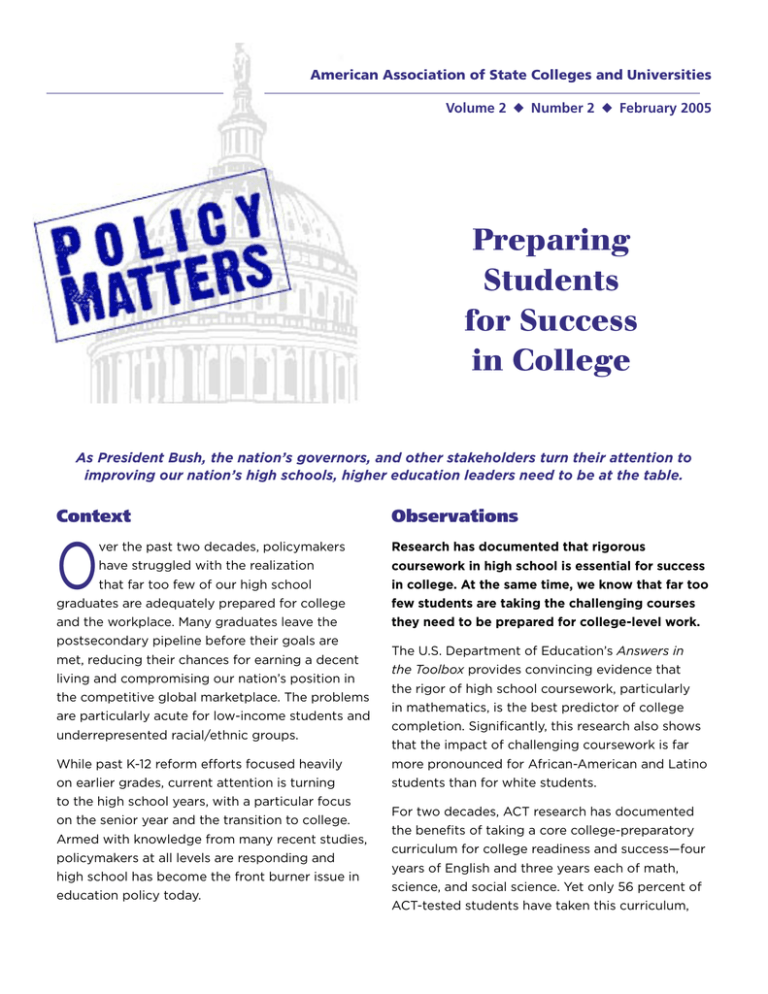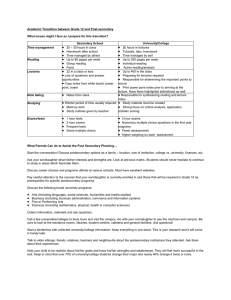Preparing Students for Success in College
advertisement

American Association of State Colleges and Universities Volume 2 ◆ Number 2 ◆ February 2005 Preparing Students for Success in College As President Bush, the nation’s governors, and other stakeholders turn their attention to improving our nation’s high schools, higher education leaders need to be at the table. Context O ver the past two decades, policymakers have struggled with the realization that far too few of our high school graduates are adequately prepared for college and the workplace. Many graduates leave the postsecondary pipeline before their goals are met, reducing their chances for earning a decent living and compromising our nation’s position in the competitive global marketplace. The problems are particularly acute for low-income students and underrepresented racial/ethnic groups. While past K-12 reform efforts focused heavily on earlier grades, current attention is turning to the high school years, with a particular focus on the senior year and the transition to college. Armed with knowledge from many recent studies, policymakers at all levels are responding and high school has become the front burner issue in education policy today. Observations Research has documented that rigorous coursework in high school is essential for success in college. At the same time, we know that far too few students are taking the challenging courses they need to be prepared for college-level work. The U.S. Department of Education’s Answers in the Toolbox provides convincing evidence that the rigor of high school coursework, particularly in mathematics, is the best predictor of college completion. Significantly, this research also shows that the impact of challenging coursework is far more pronounced for African-American and Latino students than for white students. For two decades, ACT research has documented the benefits of taking a core college-preparatory curriculum for college readiness and success—four years of English and three years each of math, science, and social science. Yet only 56 percent of ACT-tested students have taken this curriculum, Alignment Between High School Graduation and College Admissions Course Requirements Source: National Association of System heads (2002). Note: Reflects alignment in the number of courses required by high shcool and higher education. and the number has increased only two percentage points over the past decade. Recent studies have documented the gap between high school and college academics. Despite good efforts and progress over the past 20 years, there is still a significant disconnect between the K-12 and postsecondary sectors, making the transition between high school and college anything but seamless. The past 20 years have witnessed tremendous state-level educational reform at the K-12 level, with development of educational standards and assessments. Forty-two states now have statewide coursework requirements for graduation. Twenty states have implemented “exit exams” as a requirement for high school graduation, and another five will do so in the next five years. ■ alignment in both English and math (10) ■ alignment in either subject area, but not both (12) ■ no alignment in either area (28) Examining 10-year trend data on high school preparation for college, the National Center for Public Policy and Higher Education noted that 44 states had improved on at least half of the indicators (such as percent of students taking at least one upper-level math course) and the remaining states experienced at least some improvement. So are we there yet? Unfortunately, the answer is a resounding “no” as illustrated by the fact that about half of all college freshmen take at least one remedial course. There is still a great deal of variation across states in what is required for high school graduation and there is very little consensus between secondary and postsecondary education on the courses students should take in high school. [See map.] further, across secondary schools, course content can vary widely for courses with the same title. Finally, exit exams have set a floor for high school achievement, but they do not go far enough. These tests typically reflect material studied early in the high school career and have cutoff scores that are too low to assure college readiness. Given that K-12 reforms were most often driven by state legislatures without involvement by higher education, the disconnect is not surprising. For the most part, the sectors have operated without shared curriculum standards, governance, or accountability systems. On the positive side, many efforts are underway to increase the rigor of high school coursework, to develop common standards, and to bring about greater alignment of high school and college assessments. National and state initiatives are leading states, colleges and universities, and local school districts to work together to bring about change. A few states (Arkansas, Indiana, and Texas) are making strides in promoting the collegepreparatory curriculum as the default curriculum for all students. Eighteen states are developing tiered diploma systems to promote more rigorous coursework and advanced diplomas for collegebound students. Projects attempting to bridge the secondary/postsecondary gap through common standards include the Standards for Success project, Achieve’s American Diploma Project, the College Board’s Standards for College Success, and ACT’s Standards for Transition. States with efforts to align high school assessments with college admissions and placement tests include California (California State University), Georgia, Kentucky, New York, Oregon, Texas, and Washington. Opportunities for high school students to earn college credits have grown dramatically over the last decade. Increasingly, state policies are helping middle- and low-achieving students take advantage of these options, thereby encouraging college attendance, helping ease the transition to college, and giving them a jump start on earning college credits. Advanced Placement (AP), International Baccalaureate (IB), and dual enrollment options have been available to high-achieving students for many years. What is relatively new are policies that provide to middle- and low-achieving students these and other options—including distance learning, Tech Prep, and early and middle college high schools (located on college campuses and offering at-risk students high school and college courses and support services). Currently, 38 states have policies on dual enrollment, including 18 states that mandate that dual enrollment opportunities be provided to students. The National Governors Association (NGA) is among the groups supporting state policy development on postsecondary options. As part of its “Redesigning the American High School” initiative, NGA is recommending that governors work to create statewide common course agreements for accepting college-level work taken in high school and that states provide financial incentives for disadvantaged students to take AP exams. Curriculum improvements are just one component of a growing number of statewide K-16 systems designed to bring about seamless education. Statewide K-16 systems, currently found in at least 22 states, bring together representatives from K-12 departments of education and school districts, higher education coordinating boards and institutions, the business community, the governor’s office, the state legislature, and others. These initiatives strive to bring about a more coordinated education system through attention to curriculum and assessment, early outreach, teacher preparation, student financial aid systems, data and accountability systems, and joint governance structures. Conclusion Whether working through local partnerships, statewide K-16 structures, or national coalitions, colleges and universities must do more to ensure that our high school students develop the knowledge and skills necessary to succeed in college and in life. At this critical time, higher education needs to be at the table to help create a more seamless educational system that works for all. Resources Achieve, Inc. and the American Diploma Project. Launched by Achieve, Inc., in partnership with the Education Trust and the Thomas F. Fordham Foundation, the American Diploma Project was designed to restore value to the high school diploma. Reports include Ready or Not: Creating a National Association of System Heads (NASH), Aligning K-12 and Postsecondary Expectations: State Policy in Transition (2002). NASH and the Education Trust support a network of public higher education, K-12, and civic leaders who are implementing statewide K-16 initiatives. This report compares state high school graduation requirements with state postsecondary admissions requirements. nashonline.org/content/ALIGNreport.pdf National Commission on the High School Senior Year, Raising Our Sights: No High School Senior Left Behind, October 2001. This final report of the Commission recommends the “Triple A Plan,” calling for increased alignment between all levels of education, higher achievement through collegepreparatory study, and expanded and more rigorous High School Diploma That Counts (2004), Do Graduation alternatives to the traditional senior year. woodrow.org/CommissionOnTheSeniorYear/Report/ Tests Measure Up? A Closer Look at State High School FINAL_PDF_REPORT.pdf Exit Exams (2004), and The Expectations Gap: A 50-State Review of High School Graduation Requirements (2004). Pathways to College Network, A Shared Agenda: A Leadership Achieve’s latest report is Rising to the Challenge: Are High Challenge to Improve College Access and Success, 2004. School Graduates Prepared for College and Work? A Study The Pathways Network, a national alliance of organizations, of Recent High School Graduates, College Instructors, and is committed to using research-based knowledge to Employers (2005). achieve.org/ improve college access and success for underserved students. Based on review of over 650 research studies, American Council on Education (ACE), The School-to-College Transition: Challenges and Prospects, December 2004. This report summarizes research on the school-to-college this report presents recommendations for policymakers, education leaders, and others. pathwaystocollege.net/agenda/ transition, focusing on how campus leaders can help reduce the college access gap. acenet.edu/bookstore/pdf/2004_IPtransitions.pdf Standards for Success (S4S), Mixed Messages: What State High School Tests Communicate about Student Readiness for College, 2003. S4S, a consortium of 28 universities, The Bridge Project. Housed at Stanford University (Calif.), this developed a comprehensive statement of what students six-year national study explored the policies, perceptions, must know and be able to do to succeed in entry-level and practices related to the transition from secondary to university courses. This report compares the degree of postsecondary education. The final report, Betraying the alignment between these standards and state high school College Dream: How Disconnected K-12 and Postsecondary exams. cepr.uoregon.edu/pdf/Mixed_Messages.pdf Education Systems Undermine Student Aspirations (2003), outlines the disconnects between high school exit-level policies and college entrance policies. stanford.edu/group/bridgeproject/ Center on Education Policy (CEP). State High School Exit Exams: A Maturing Reform, August 2004. CEP’s third annual report on state high school exit exams reviews the status, characteristics, and effects of exit exams. cep-dc.org/highschoolexit/ExitExamAug2004/ ExitExam2004.pdf U.S. Department of Education, Office of Vocational and Adult Education (OVAE), Accelerating Student Success Through Credit-Based Transition Systems. This initiative is designed to investigate the ways in which credit-based transition programs may support the transition of middle- to lowachieving students from secondary to postsecondary education. Reports include Promoting College Access and Success: A Review of Credit-Based Transition Programs (2003) and State Dual Enrollment Policies: Addressing Access and Quality (2004). ed.gov/about/offices/list/ovae/pi/cclo/cbtrans/index.html Contact: Alene Russell, State Policy Scholar at 202.478.4656 or russella@aascu.org

